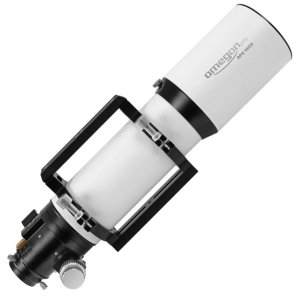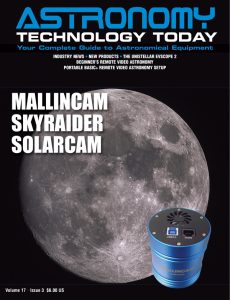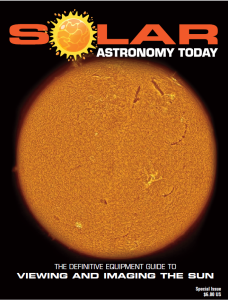Four new Omegon Triplet Apos have been introduced and are available in apertures of 85mm, 96mm, 106mm and 140mm.
 The new Omegon Triplet Apos use Hoya FCD100 glass from Japan. This optical glass has extremely low dispersion and is equivalent to that of the well-known FPL-53 glass. As a result, the telescopes offer high-contrast images with excellent color purity, even at high magnifications. The inner baffles protect against reflections for even better contrast when observing and in astrophotography.
The new Omegon Triplet Apos use Hoya FCD100 glass from Japan. This optical glass has extremely low dispersion and is equivalent to that of the well-known FPL-53 glass. As a result, the telescopes offer high-contrast images with excellent color purity, even at high magnifications. The inner baffles protect against reflections for even better contrast when observing and in astrophotography.
The 85mm and 96mm models include a 2.5-inch hybrid focuser and the 106mm and 140mm utilize a 3.5-inch hybrid focuser. These 360-degree rotatable and lockable focusers are based on the Crayford design, but also include an additional guide rail in the form of a toothed rack with helical grooves. The combination of these makes the focusers particularly precise and yet stable and provides the ability to easily connect a number of accessories, from adapters to large eyepieces or heavy camera gear with a payload up to 10kg.
In addition to the classic 2-inch (with 1.25-inch reducing adapter) connection for eyepieces and cameras, the new Omegon Triplet Apos also offer an internal M63 thread so that you can easily and stably connect a flattener or reducer.
With the carrying handle it easy to transport the telescopes. In addition, the handle also serves as a Vixen style mounting rail for accessories attached in parallel.
The new Omegon Triplet Apos are available in four versions with the following specifications:
Omegon Pro APO AP 85/510 FCD-100 Triplet ED
– Aperture (mm): 85
– Focal length (mm): 510
– Aperture ratio: f/6
– Resolving capacity: 1.35
– Limit value (mag): 11.4
– Light gathering capacity: 150
– Max. useful magnification: 170
– Lens design: Triplet
– Glass material: HOYA FCD-100
– Tube weight (kg): 4
– Tube diameter (mm): 95
– Tube length (mm): 440
– Tube material: Aluminum
– Coating: FMC
– Stray light baffles in the OTA: Yes
-Dew cap diameter (mm): 105
Omegon Pro APO AP 96/575 FCD-100 Triplet ED
– Aperture (mm): 96
– Focal length (mm): 575
– Aperture ratio: f/6
– Resolving capacity: 1.2
– Limit value (mag): 11.7
– Light gathering capacity: 190
– Max. useful magnification: 192
– Lens design: Triplet
– Glass material: HOYA FCD-100
– Tube weight (kg): 5
– Tube length (mm): 500
– Tube material: Aluminum
– Coating: FMC
– Stray light baffles in the OTA: Yes
– Dew cap diameter (mm): 122
Omegon Pro APO AP 106/700 FCD-100 Triplet ED
– Aperture (mm): 106
– Focal length (mm): 700
– Aperture ratio: f/6.6
– Resolving capacity: 1.08
– Limit value (mag): 11.9
– Light gathering capacity: 230
– Max. useful magnification: 212
– Lens design: Triplet
– Glass material: HOYA FCD-100
– Tube weight (kg): 6
– Tube length (mm): 560
– Tube material: Aluminum
– Coating: FMC
– Stray light baffles in the OTA: Yes
– Dew cap diameter (mm): 145
Omegon Pro APO AP 140/910 FCD-100 Triplet ED
– Aperture (mm): 140
– Focal length (mm): 910
– Aperture ratio: f/6.5
– Resolving capacity: 0.82
– Limit value (mag): 12.5
– Light gathering capacity: 400
– Max. useful magnification: 280
– Lens design: Triplet
– Glass material: HOYA FCD-100
– Tube weight (kg): 10.5
– Tube length (mm):850
Tube material: Aluminum
– Coating: FMC
– Stray light baffles in the OTA: Yes
– Dew cap diameter (mm): 182
You can learn more about the new Omegon Triplet Apos here.

 And to make it easier for you to get the most extensive news, articles and reviews that are only available in the magazine pages of Astronomy Technology Today, we are offering a 1-year magazine subscription for only $6! Or, for an even better deal, we are offering 2 years for only $9. Click here to get these deals which only will be available for a very limited time. You can also check out a free sample issue here.
And to make it easier for you to get the most extensive news, articles and reviews that are only available in the magazine pages of Astronomy Technology Today, we are offering a 1-year magazine subscription for only $6! Or, for an even better deal, we are offering 2 years for only $9. Click here to get these deals which only will be available for a very limited time. You can also check out a free sample issue here.
The Sun is more active than it’s been in years and if that’s not enough, we have the Annular Solar Eclipse on October 14, 2023 and the Total Solar Eclipse on April 8, 2024! If you’d like to learn more about the technology behind solar observing, solar imaging and more, you can check out our free publication, “The Definitive Guide to Viewing and Imaging the Sun”. You don’t have to sign up or provide any information, simply click here and enjoy reading!



